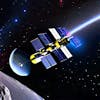S02E30: Voyager's Triumph // Bubbletrons // The Wonders of Graphene
- **Date:** 7th August 2023- **Host:** Steve Dunkley
**Main Topics Covered:**
1. **Personal Updates:** - Steve celebrated his son and his partner Kate's birthdays in Sydney. - Lunch at a famous Australian landmark.
2. **SpaceX News:** - SpaceX tests...
- **Date:** 7th August 2023- **Host:** Steve Dunkley
**Main Topics Covered:**
1. **Personal Updates:** - Steve celebrated his son and his partner Kate's birthdays in Sydney. - Lunch at a famous Australian landmark.
2. **SpaceX News:** - SpaceX tests their new booster. - Static fire test conducted for the Starship First Stage prototype, Booster 9.
3. **Graphene in Space:** - The wonder material graphene is being researched for use in space building and development. - Scientists from the Italian Space Agency discuss graphene's potential role in space exploration. - Up to 1.9% of interstellar medium carbon is made of graphene.
4. **Voyager 2 Update:** - NASA reestablishes contact with Voyager 2. - Voyager 2's history and its journey through the solar system. - Voyager 1 and 2 carry golden records with information about Earth.
5. **Bubbletrons:** - A phenomenon from the early universe where massive bubbles may have emerged and collided. - These bubbles could have been responsible for the creation of dark matter particles and microscopic black holes. - The bubbles' expansion and collision might have created gravitational waves.
6. **Other Space News:** - Discovery of an unusual Jupiter-sized planet, T-O-I-G-4860B, orbiting a low mass star. - NASA's collaboration with Axiom Space for private astronaut missions. - NASA announces crew members for SpaceX Crew 8 mission to the International Space Station.
**Closing Remarks:**Steve and Halley, the digital reporter, wrap up the episode, touching on the incredible properties and potential of graphene in space technologies.
For more Astronomy Daily visit www.spacenuts.io
AI Transcript
Well, G'day and welcome to this episode of Astronomy Daily. It's the 7th of August 2023 on your host Steve Duncley. Thanks for being with us.
[Bell ringing]
It's so great to have you with us again on our lovely winter's day here on the East Coast of Australia.
Oh, it's great. And with us again is our wonderful faithful digital reporter, Halley.
Great to be back, Steve. I hope you had a great week.
Well, we had yet another birthday, Halley. Actually, it was two birthdays.
Wow. You humans sure love birthdays. Who was it this time?
Well, this time it was my son and his lovely partner Kate. They celebrated together in Sydney, which is just a short two-hour drive south of here,
I live in Newcastle, and we had a very pleasant lunch with some family members at the famous Australian landmark Etomoga pub.
That sounds cool. Did you have some traditional Australian tucker?
Oh, I had the salmon.
Oh, is that traditional?
Oh, well, it is for me.
That has good, then.
Excellent, Halley. You're learning our quirky human ways very nicely. Birthdays good, salmon better.
Got it.
So what have you caught first today, Halley?
Okay, there's a story about SpaceX firing up their new booster, the wonder material graphene being researched for use in space building and development, a couple of fast orbiting stars,
Bubble tronds.
Bubble tronds?
Yes, bubble tronds. And I know what you're thinking, Steve.
Oh, yeah. What am I thinking, Halley?
Those giant bubbles from the TV series, The Prisoner. That's not it.
Oh, yeah. That is what I was thinking.
So what else is going on, Steve?
Well, there's some great research about a wonder material called graphene, which I'll be talking about later,
and also some fantastic news about Voyager 2.
I am so glad that NASA has managed to reestablish contact with Voyager 2 after losing contact last week.
Yes, they thought outside the box and did something pretty remarkable.
I always feel sorry for those lonely little space probes.
Well, as the story goes, Halley, NASA has succeeded in real establishing full contact with Voyager 2.
Using its highest power transmitted has sent an interstellar shout that right at the distant probes antenna orientation,
the space agency said on Friday, a series of planned command sent the spaceship to the spaceship on July 21.
Mistakenly, cause the antenna to point two degrees only from Earth, compromising its ability to send and receive signals, then endaget its mission.
And the situation was not expected to resolve itself until at least October 15, when Voyager 2 was a schedule to carry out an automated re-alignment maneuver.
But on Tuesday, engineers enlisted the help of multiple Earth observatories that formed the Deep Space Network DSN to detect a carrier or heartbeat wave from Voyager 2.
Though the signal was still too faint to read the data it carried.
In a new update on Friday, NASA's Jet Propulsion Laboratory, which built and operates the probe, said it had succeeded in a long shot effort to send instructions that right at the craft.
According to a statement released by JPL, this so-called interstellar shout required 18.5 hours travelling at the speed of light to reach Voyager 2,
which took 37 hours for mission controllers to learn whether or not the command had actually worked. The probe began returning sides and telemetry data at 12.29 a.m. eastern time on August 4, indicating it's operating normally and that it remains on its expected trajectory.
That's great news. Voyager 2 left the predictive magnetic bubble, provided by the Sun called the Heliosphere in December 2018 and is currently travelling through the space between stars.
While leaving our solar system it explored Jupiter, Saturn and became the first and so far only spacecraft to visit Uranus and Neptune.
Voyager 2's twin Voyager 1 was mankind's first spacecraft to enter the interstellar medium in 2012 and is currently 15 billion miles from Earth, both carry golden records, 12 inch gold plated copper disks, intended to convey the story of our world to extra terrestrials, should they ever encounter them.
This includes a map of our solar system, a piece of uranium that says as a radioactive clock allowing recipients to date the spaceship's launch and symbols that convey how to play the actual record.
The contents of the disc selected for NASA by a committee shared by a legendary astronomer Carl Sagan, including coded images of life on Earth as well as music and sounds that can be played using an included stylus.
For now, Voyager's continue to transmit back scientific data, though their power banks are expected to be eventually depleted sometime after 2025.
They will then continue to wander the Milky Way potentially for an eternity in silence.
Wow, they are hearty little probes, aren't they?
They just keep on ticking, alright. Now, how do you view it? Some short takes for us today?
Here they are, everyone.
An international team of scientists have discovered an unusual Jupiter-sized planet orbiting a low mass star called T-O-I-G-4860, located in the Corvus constellation.
The newly discovered gas giant, named T-O-I-G-4860B, is an unusual planet for two reasons.
Stars of such low mass are not expected to host planets like Jupiter, and the planet appears to be particularly enriched by heavy elements.
The planet was initially identified using NASA's Transiting Exoplanet Survey Satellite as a drop of brightness while transiting in front of its host star, but that data alone was insufficient to confirm that it was a planet.
The team used the Speculus South Observatory, located in the Atacama Desert in Chile, to measure the planetary signal in several wavelengths and validated the planetary nature.
The astronomers also observed the planet just before and after it disappeared behind its host star, noticing that there was no change in light, meaning the planet was not emitting any.
Finally, the team collaborated with a Japanese group using the super-uteloscope in Hawaii.
Together they measured the mass of the planet to fully confirm it.
George Transfield, one of those PhD students, who recently submitted her thesis at the University of Birmingham, explains, "Under the canonical planet formation model, the less mass a star has, the less massive is the disc of material around that star."
Since planets are created from that disc, high mass planets like Jupiter were widely expected not to form.
However, we were curious about this and wanted to check planetary candidates to see if it was possible.
T-O-Y-A-4860 is our first confirmation and also the lowest mass star hosting such a high mass planet.
A hint of what might have happened is hidden in the planetary properties, which appear particularly enriched in heavy elements.
We have detected something similar in the host star too, so it is likely that an abundance of heavy elements catalyzed the planet formation process.
In a renewed commitment to the growth of private space ventures, NASA has announced another joint mission with Axiom Space.
This mission, which will be the fourth private astronaut initiative, is slated for a tentative launch in August 2024 from NASA's Kennedy Space Center in Florida.
Axiom Mission 4 has been scheduled to dock with the space station for a period nearing 14 days.
However, the final launch date will be contingent on prevailing spacecraft traffic to the space station and other relevant factors.
To ensure seamless operations, NASA and Axiom space will be meticulously aligning in-orbit tasks for the private astronauts in conjunction with station crew members and on-ground flight controllers.
Previous collaborations between the two entities are noteworthy.
Just this March, Axiom Space was chosen by NASA for the third private astronaut mission, expected to launch in January 2024.
NASA Friday announced four crew members that will fly on NASA's SpaceX Crew 8 mission for a long-term stay on the International Space Station.
The crew includes NASA astronauts Commander Matthew Dominick, Pilot Michael Barat, and Mission Specialist Jeanette Epps, along with Rose Cosmos Cosmonaut Mission Specialist Alexander Gribankin.
They will all join Expedition 70 and 71 crew members aboard the ISS in early 2024.
The station is a critical testbed for NASA to understand and overcome the challenges of long-duration spaceflight and to expand commercial opportunities in low-earth orbit NASA said.
In the 22 years that humans have inhabited the ISS, 244 people from 19 countries have been onboard and worked in the unique microgravity laboratory that has hosted over 3,000 research and education investigations.
The upcoming mission will be the eighth space station rotational mission. NASA works with the American Aerospace Industry to provide transportation to and from the station using American-made rockets and spacecraft.
The Starship First Stage prototype known as Booster 9 conducted a static fire test today, August 6, briefly igniting its 33 Raptor engines while anchored to the orbital launch mount at SpaceX's Star Base site in South Texas.
Not all of the engines performed perfectly, for of them shut down prematurely, SpaceX representatives said during a webcast of today's test.
But 29 out of 33 isn't bad, and both Booster 9 and the orbital launch mount emerged from the test in one piece.
So there's plenty of reason for SpaceX to celebrate.
Starship SpaceX's next-gen transportation system, which is designed to get people and cargo to the moon, Mars and beyond, has one full-up flight test under its belt.
That mission launched from Star Base on April 20 with the goal of sending the ship 24 upper-stage prototype partway around Earth, splashdown was targeted for the Pacific Ocean near Hawaii.
That didn't happen, however, Starship experienced several problems shortly after liftoff and SpaceX sent a self-destruct command, destroying the vehicle high over the Gulf of Mexico.
The April 20 launch also caused considerable damage to starbase orbital launch mount and some surrounding infrastructure.
To keep that from happening again, SpaceX installed a water deluge system beneath the mount, a water spouting steel plate designed to dampen the tremendous energy generated by super heavies 33 raptors.
The new deluge system appeared to work well during today's test, as copious amounts of water jetted upward toward the firing raptors.
Here are those bubble-tron Steve, are you ready?
Oh, I can hardly wait it's either something from science fiction or a new kind of chewing gum.
You're a silly human.
The extremely early universe featured the most cataclysmic, transformative and energetic events that ever occurred.
Driving these energies was the expansion of the cosmos and the resulting fragmentation of the fundamental forces of nature.
And in that fragmentation, massive bubbles may have emerged and collided with each other, powering up energies that would put to shame even our most advanced human-made particle accelerators, new research published June 27 on the pre-print database AR-14 suggests.
Those awesome energies could have flooded the universe with dark matter particles, microscopic black holes, and much more, the researchers wrote.
And the name of those ultraenergetic, early universe structures? Meet the bubble trunks.
The four fundamental forces of nature, electromagnetism, strong nuclear, weak nuclear and gravity, are not always so different.
At high energies, these forces begin to merge.
We can already detect this in our most powerful particle colliders, where electromagnetism and the weak nuclear force merge into a united and electroweak force.
While not proven, physicists strongly suspect that at even higher energies the other forces also merge into a single, unified force.
But the only time the universe had the energies needed to do this was less than a second after the big bang.
As the cosmos cooled and expanded from that early state, the forces split off from each other in titanic moments of phase transition.
This splitting might have been smooth and serene, like the transition of ice melting into water, or incredibly violent, like the transition of water boiling into vapor.
If the transitions were violent, then the universe could have been briefly filled with gigantic bubbles, the new research suggests.
Outside these bubbles, the unified forces remained. But inside the bubbles, the cosmos would have been completely different, with the forces split off from each other.
Eventually these bubbles would have expanded and collided, completely converting the universe into the new reality.
But these bubbles wouldn't just have come and gone without leaving a trace, fizzing like an open soda can.
The bubbles would have carried truly enormous amounts of energy, orders of magnitude more energy than any human made or natural process in the present day cosmos.
The expanding edges of the bubbles could accelerate any nearby particles to incredibly high speeds.
Those particles would then slam into others, just like they do in laboratory particle accelerator experiments, creating a shower of released energy and new particles.
Additionally, the bubbles would have eventually merged.
The researchers discovered that these bubble trunks could have reached the energy's necessary to trigger the formation of hypothetical dark matter particles.
These particles would have enough mass and abundance to explain the observed amount of dark matter in the universe, according to the team's calculations.
They could also have been factories of much more exotic objects, like microscopic black holes that immediately evaporated, adding their energy to the mix.
Most importantly, the researchers discovered that the expansion and collision of the bubble trunks would have created a cacophony of gravitational waves.
Those gravitational waves would ring the whole universe like a gigantic bell and persist in the cosmos today, billions of years later.
Good grief, Halle, so that's bubble trunks. Sure is. Chew on that one. Incredible stuff. And that's all from me for now. Back to you, Steve.
Pastronomy! Daily! The bug cut!
Thanks again for listening in you with Steve, don't clear on astronomy daily. We've already covered quite a bit of territory today with Halle, our Intrepid Digital Reporter, and we continue the stories right now.
Now, graphene has long been put forward as a wonder material. Undeniably, it's been a standing properties stronger than steel, better than electrical conductor than copper, and lighter than almost anything else with similar properties.
And while it's been partially adopted into space-faring technologies, many use cases remain where a pure form of the material could dramatically benefit the space industry.
To detail those opportunities, a group of scientists from the Italian Space Agency recently released a paper that looked at graphene's role in space exploration and where it might stand to make an even bigger impact shortly.
When used in space technologies, it's simply returning to a place where it already exists naturally. Research has shown that up to 1.9% of interstellar medium carbon is made of graphene.
It's created during the destructive process of a star going through its death throws, and spreads throughout the galaxy as part of that process.
Unfortunately, recreating a supernova isn't that easy here on Earth, just asking it a nuclear physicist, and creating graphene here on Earth isn't easy either.
At least not at the scale necessary for its full material properties to become realized, but even a little graphene added to the mix makes a huge difference. Typically, engineers combine graphene with different materials and polymers for space applications, giving a rise to a class of materials known as nano composites.
Even this tiny amount of wonder material can have a significant positive benefit for the result composite.
Whether increasing its thermal conductivity or stiffness, some composites can even be used as sensors with their output controlling things like, say, rocket positioning, other use cases like solar sails and tanners, anti-ware systems, show how versatile graphene can be.
But where do we go from here? Still isn't a way to successfully craft pure graphene with physical properties we desire, but there's plenty of research on how to do that.
As with so many other areas of scientific research lately, China is leading the charge in developing that methodology, according to the paper, China controls 71% of global patents on graphene, and eight of the ten universities researching graphene are located in the country.
China also has a robust space program, but its space economy is not as well developed as the US or Europe.
So it may take a while before any advancements in the country are made or adopted into the space industry.
But overall, the paper does a reasonable job of describing potential use cases, obstacles and opportunities for the use of graphene in space.
There's still work to do before the wonder material becomes useful in the harshest environments, however given its potential, an artificial form of graphene will undoubtedly one day return to the interstellar void where it was initially made.
Now astronomers have discovered a pair of star-like objects orbiting each other extremely quickly, with an entire year lasting just 1.9 hours.
Wow, catchably named ZDFJ2020+5033, wow, the system consists of one object which is definitely a small star, and another that straddles the boundary between star and planet.
The two objects appear to be very old and understand how they can't be orbiting so close together as teaching astronomers more about how solar systems change and evolve.
The planet-like object in the pair is classified as a brown dwarf, a failed star without enough mass to jump-start still a fusion in its core.
But this particular object is right on the boundary between a brown dwarf and a star, so astronomers can't be sure which it is for sure.
Though they suspect the latter because it is so much dimmer than its partner, the brown dwarfs orbital period is 7 times faster than previous record-holding brown dwarf.
It is so close to its partner that both could easily orbit each other inside our own Sun, but the paper released this month suggests that they didn't actually form like this.
Both components must have been significantly larger when they were young than they are today, implying that the orbit has shrunk significantly the author's right.
Understanding that the process is key to unlocking some of the secrets of the solar system formation, the primary mechanism at work they believe is something called magnetic breaking.
Stars have powerful magnetic fields when solar flares and coronal mass ejections and other phenomena related to solar wind eject material from a star.
The material is captured by magnetic fields and is carried far out from the star eventually escaping altogether.
But before it escapes, the material continues to spin with the star in its magnetic field, just like a figure skater throwing their arms out to spin slower.
This material slows a star's spin. In a binary system, the magnetic fields of both stars work together to slow their orbital period around each other, like two figure skaters holding hands with arms out-right.
Over millennia, not only did the stars lose mass, they also circle each other closer and closer. Current models used by astronomers suggest that magnetic breaking is most pronounced in stars that are fully convective.
They are massive enough that the convection zone of the star extends all the way into its interior. But this binary pair is made up of two very small stars that are not fully convective.
This strongly suggests that magnetic breaking remains efficient below the fully convective boundary in at least some stars, contrary to the common assumption in many binary evolution models the paper argues.
That means that we might need to change how we think about future evolution of binary pairs.
ZD-DFJ 2020+5033 for example is expected to pass the Roche limit in 1.3 billion years according to current models.
At that time, the brown dwarf will be ripped apart by the gravity of its partner as it gets too close. But if magnetic breaking is indeed in effect for these small stars, that timeline will come much faster within just tens of millions of years.
The implications are clearly significant. To get a better understanding of what's going on, astronomers need to find more close orbiting binary star brown dwarf pairs to make sure this isn't just an outlier.
But that's easier said than done, although they are expected to be common brown dwarfs are so dim that they are difficult to find resulting in what astronomers call a brown dwarf desert in their data sets.
Luckily there are three new instruments that will excel at finding exactly these objects. Palomar Observatory's wide field infrared transient its explorer Winter, which began operations in 2021.
The Vera Ruben Observatory, expected to begin survey in 2024 and the Nancy Grace Roman Space Telescope launching in 2027.
And thanks again for listening to Astronomy Daily. I'm Steve Dunkley or Hosed. Thank you very much for joining us again.
I hope you'll see us again next week as we bring you more space, science and stuff.
Don't forget you can catch all the past episodes of Astronomy Daily and our parent podcast Space Nuts with Andrew Dunkley and Professor Fred Watson at spacenuts.io or bitesz.com.
Bye for now.
New to Astronomy Daily - The Podcast?
Here are some great episodes to start with.













